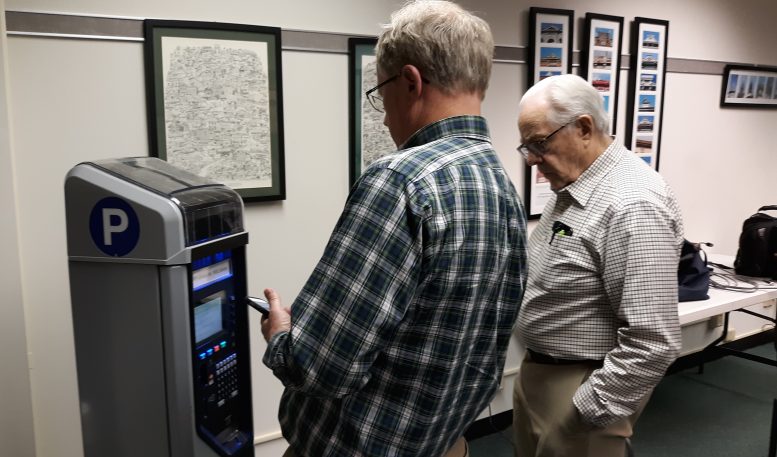By JAN LARSON McLAUGHLIN
BG Independent News
Once the “holiday” of free parking concludes at the end of the year, motorists will see some parking changes downtown – most noticeably, kiosks in every city parking lot.
Bowling Green City Council voted Monday evening to proceed with an ordinance establishing parking costs, time limits and the extension of parking kiosks to all the city lots.
The ordinance calls for the cost of parking to increase from 25 cents to 50 cents per hour, extends the two-hour limit to three hours, and provides free handicapped parking.
These changes are based on recommendations from a downtown parking task force with seven members – four representing downtown property owners and three representing business owners who don’t own their buildings. Several options were discussed, including higher parking fees or free parking subsidized by the business and property owners.
The current funding structure no longer supports the downtown parking needs – so sticking with the status quo is not an option.
The problem lies in the fact that the city’s parking fund is intended to pay for all aspects of downtown public parking. This includes paving, ongoing maintenance of the parking lots, enforcement costs including personnel and equipment, parking meters and kiosks, and taxes on the parking lots.
Last year, the parking fund had a projected deficit of $21,000, as the balance continues to drop. Also looming is the fact that nearly all the downtown parking lots are in need of paving.
While offering free parking to downtown shoppers and diners sounded good, it also presented challenges in ensuring turnover in downtown parking. Some committee members were concerned that the shared parking model would be abused by those working and living downtown – leaving less space for customers.
Some members of the community continue to have concerns about using the parking kiosks. However, those wanting to use credit cards have embraced the kiosk system. It was recommended that if the city goes with kiosks in all downtown parking lots, that small shelters or covers be installed to protect customers from bad weather.
At the last city council meeting, council members Bill Herald, Sandy Rowland and John Zanfardino were not ready to proceed with expanding the kiosks to all city parking lots downtown. In January, these council members had asked for more discussion before proceeding.
Despite the requests for more discussion, council voted at the last meeting to transfer $59,106 in previously appropriated money into a fund to purchase more kiosks.
Herald said that during his door-to-door campaigning, he encountered many citizens who avoided parking in Lot 2 – behind SamB’s and Waddington’s – because of the kiosks.
Rowland joined Herald in questioning if the decision was final to proceed with kiosks in more parking lots downtown.
The business people are concerned, she said. “No one has complained about paying another quarter,” but business owners already feel they are a step behind shops in communities that don’t charge for parking.
In addition to the cost, is the problem that some patrons have of using the kiosks, Rowland said.
“Kiosks terrify people,” she said.
Zanfardino said he also recalled that some on council had asked for more discussion prior to the actual purchase of more kiosks.
“I know the kiosks we had were universally viewed by the businesses as a real deterrent,” he said, suggesting that council proceed with caution.
The city’s first attempt at parking kiosks was in Lot 2 – and proved to be a mixed success, since the type of parking kiosks used there were confusing to many.
So city officials searched for a better type of kiosk that is more user-friendly.
Council member Bruce Jeffers said downtown business owners participated in the process of selecting the new type of kiosks to be used.
“They were satisfied with the plan we came up with,” he said. “I don’t know why we would suddenly get cold feet on this.”
So at Monday’s meeting, Aspacher announced that several personal discussions were held with council members since the last meeting – eliminating the need for another meeting to discuss the kiosks.
But Herald continued to question exactly when the decision was made to definitively proceed with more kiosks. He said he has been unable to find that decision in council minutes or in emails from city administration.
Herald asked Municipal Administrator Lori Tretter to find minutes of that decision and send them to him. Aspacher responded that it is “unreasonable” to ask the city administration to research past decisions for council members.
But Herald insisted that the minutes from the January council meeting did not definitively say that the city would extend the kiosks.
“Something that directly impacts the citizenry as much as the kiosks do,” is worth looking into, he said.
Jeffers said the decision was made after several months of discussion with the downtown committee.
“There were a lot of pieces to the puzzle,” Jeffers said. “I’m very satisfied with the work of the downtown committee. This is the best possible approach.”
Herald also asked about his request that the parking “holiday” be extended into the spring, since several businesses have been struggling during the prolonged construction downtown.
Aspacher said he had spoken with Tretter and City Finance Director Brian Bushong, who felt extending the free parking would be unwise for the parking budget. Aspacher reminded council that the parking “holiday” had been started early in August to help businesses.

